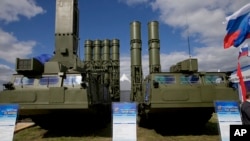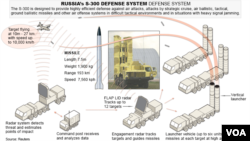Russian President Vladimir Putin has lifted a ban on the sale of an air defense system, known as the S-300, to Iran providing that country with one of the world’s most advanced systems designed to shoot down high-flying aircraft and low-flying cruise missiles.
Retired Air Force General David Deptula [former Air Force Deputy Chief of Staff for Intelligence, Surveillance and Reconnaissance] said in addition to potent missiles, the system has powerful radars.
“It can track up to 100 targets simultaneously. It can travel and engage targets as far away as 80 miles and at altitudes over 3,000 feet. It can track targets and engage them down to 20 to 30 feet off ground level and it travels at six times the speed of sound,” said Deptula.
S-300 Very Mobile System
Defense analyst Ivan Oerlich [George Washington University] said the system has another benefit.
“One of the advantages of a system like the S-300 is that it’s highly mobile. It can operate from a spot for some length of time, maybe as short as 20 or 30 minutes, they can pack everything up and then everything is on trucks and they can drive to a new location and set up in just five to six minutes and then turn on again,” said Oerlich.
Greg Thielmann with the Arms Control Association said the Iranians have considerable experience with surface-to-air missiles.
“Since their fixed-wing aircraft capability is not very good - they haven’t had new inputs into that, and in fact they are still flying around some of the aircraft they obtained from the shah era - they have relied heavily on surface-to-air missiles. They used them to defend themselves during the war with Iraq,” said Thielmann.
System Could Deter Air Strikes
General Deptula said Iran could place the sophisticated S-300 air defenses around their nuclear plants, which would “significantly complicate the calculus for planning any military option involving air strikes.”
Israel has threatened a military strike against Iran’s nuclear facilities to make sure Tehran does not build a bomb. And the United States has said “all options are on the table” - a euphemism for carrying out a military strike.
In 2007, Russia signed a deal with Iran to provide Tehran with the S-300 air defense system. But in 2010 it postponed delivery after pressure from Western countries and after the U.N. Security Council imposed strict sanctions on Iran.
Now Moscow has decided to go ahead with the sale. Russian officials say the decision was prompted by progress in recent talks between Iran and six world powers on Tehran’s nuclear ambitions.
U.S. officials describe the move as “not constructive” and “unfortunate.”
Sale Doesn't Violate Sanctions
Thielmann said the sale does not violate current international sanctions on Iran.
“When the U.N. Security Council passed a much more stringent sanctions resolution in 2010, it included a provision that basically banned sales of what is generically described as heavy weapons, and that meant large caliber artillery systems, combat aircraft, attack helicopters, warships and certain kinds of missiles. But in the definition of the missiles, it did not include surface-to-air missiles,” he said.
Thielmann said the Russians haven’t done anything in the sale inconsistent with their international obligations.















